Ultimate Guide to Building a Sales Pipeline
B2B sales pipelines are the aces up the sleeves of many successful sales and marketing teams. The reason why a sales pipeline is important is that it provides a clear view of the status of each prospect, how much time they have spent on each buyer's journey stage, and how close they are to making a purchase.
With this knowledge, sales efforts may be more fitting to address prospects' demands while team leaders can make data-driven decisions to accelerate sales efficiency and establish a more secure revenue source.
According to a LeanData report, 48.8% of the surveyed B2B marketers agreed that their pipeline growth was a top priority for their go-to-market organization this year. That said, crafting an optimal and scalable B2B sales pipeline can be a challenging task if the understanding of the buyer's cycle is not sound enough.
In this article, we’ll discuss what a sales pipeline is, its impact on the sales experience, and the steps you can take to build your sales pipeline successfully.
What Is a Sales Pipeline?
A fair sales pipeline definition refers to the visual representation of the journey that every lead must take before becoming a customer. To understand a pipeline in sales, business development managers must be willing to work under a step-by-step structure that guides both prospects and sales reps through the buying process in a subtle and organized manner.
Sales pipelines also offer an overview of a sales rep's account progress, the effectiveness of each moment of truth, and how leads are flowing for the whole team. This allows sales managers to predict how many deals will be completed in a specific time frame and create strategies to maintain or boost the team's results.
What does a sales pipeline look like?
Marketers and vendors often visualize sales pipelines as a horizontal bar divided into various sales process stages. Leads and prospects move from one step to another; tracking this movement gives you a better way to monitor your sales efforts.
How does a sales pipeline differ from a sales funnel?
While a sales funnel is all about leads, the sales pipeline is all about deals. The pipeline in sales involves every stage taken in the sales process to move the deal from start to close. This sales pipeline example shows how it differs from a sales funnel: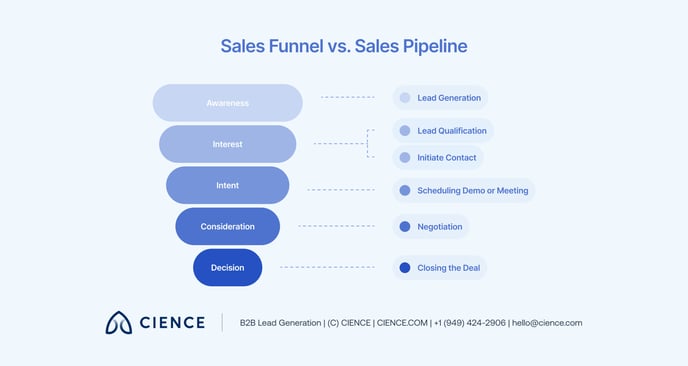
What are the different types of sales pipelines?
The sales pipeline varies across different industries, but it could mean and look different for your company depending on your industry, niche, products, services, customers, and more. So you can’t expect a one-size-fits-all approach to building or growing a sales pipeline. That said, you need a roadmap to get started before customizing it to your own.
Considerations for Creating a Sales Pipeline
Before crafting an optimal sales pipeline, business leaders must have a clear picture of the results their current sales process provide at the moment. Some sales managers try to boost their numbers out of sheer force, failing to understand that their lead generation problems could originate somewhere else in the buyer's journey.
Once the B2B sales pipeline is up and running, prospects should be able to flow as effortlessly as possible: entering the early filters of the CRM through engaging CTAs, staying at each stage only during a very specific time frame, and coming out from the tunnel ready to make a purchase.
For this reason, it is advisable to confirm that the following factors are well-grounded, as they will be the foundation for the whole pipeline-building strategy:
1. Define revenue objectives.
No sale action should ever be deployed without a clear goal. Establishing revenue objectives is the most valuable indicator of success for marketing and sales teams. Business reps can get lost in their daily activities without the compass that only accurate, achievable objectives can offer.
2. Craft buyer personas.
A buyer persona (BP) is a guide that helps sales and marketing teams better understand potential buyers and effectively engage with them at any sales stage. The BP should be based on a comprehensive analysis of all your customers and must include a full fictional name and even a photo of the character so they can be treated as real individuals with authentic needs.
3. Consolidate the lead nurturing process.
Inbound marketing strategies are essential to nurturing prospects in the early stages of the buying process. Every B2B sales pipeline should be able to trust the content pieces that aim to educate possible buyers about their needs and how to solve them.
4. Examine the lead conversion protocol.
On the other end, outbound efforts should be well tested and polished to face all kinds of rejections. Cold calling scripts, email templates, and everything in between need to be continually upgraded depending on the results of each interaction with each prospect.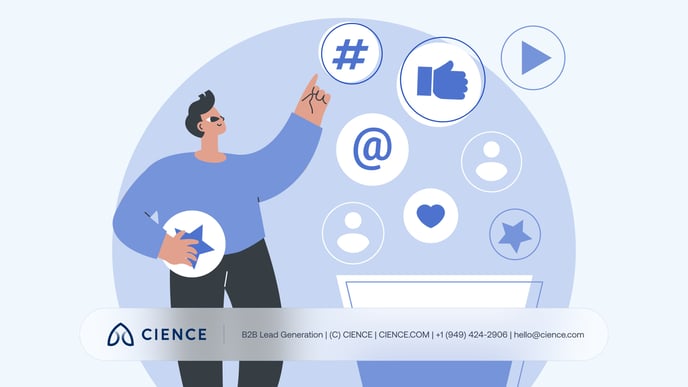
How to Build a Sales Pipeline: 8 Steps
Given how crucial a sales pipeline is as a tool for closing deals, you should take the time to construct it correctly. Before you begin creating sales pipeline stages, follow these eight essential steps on how to build a sales pipeline for business:
1. Know your product, prospect, and pitch.
First impressions last. So to build a sales pipeline, start by identifying your product, prospect, and pitch. Use these techniques to get your message across more concisely:
- Product: To appear credible in front of a potential consumer, you must be familiar with your product. You should be able to answer all of their queries and dispel their uncertainties with total assurance. Knowledge of the product allows you to have compelling conversations about the product or service.
- Prospect: You must determine your target audience, i.e., who you are marketing to. Understanding your potential customer will help you approach them more effectively since you will know when to say what.
- Pitch: After learning about the product and the target clients, create a pitch that the consumer cannot refuse. It should address the issue the prospect is experiencing. Your sales pitch is essential if used well.
2. Work with the right tools.
A B2B sales pipeline is as good as its sales software tools. Customer relationship management (CRM) platforms and customer data platforms (CDPs) are vital to correctly process all the information related to each action taken by the lead.
The only way to upgrade a sales pipeline is by confirming data-based results. The more validated data is available for sales managers, the easier it is to identify the pain points and passion points inside the current prospecting process.
3. Identify and segment a list of prospective buyers.
In this instance, the principle of one-size-fits-all does not work. Account-based marketing efforts can be defined as a set of marketing strategies that focus only on very specific, highly profitable accounts.
To promote the target account selling response, contacts must go through different validation and classification processes to confirm their value, intent, and compatibility with the provider. These filtered prospects are also known as ideal customer profiles (ICPs): elaborated files that hold the description of accurate, perfect-matching possible buyers.
Once the ICPs are correctly gathered and organized in tiers, they can enter the target account list. This document should state every detail you know about your ideal customer, for it will serve your team as a step-by-step guide on which company they should reach first, at what time, and through what channel.
By applying data segmentation techniques, vendors and advertisers should be able to assemble their ICPs into specific categories to make them easier to target with tailor-made campaigns.
Here are several ways to segment your prospects:
- Demographics: Prospects must be categorized by gender, age, ethnicity, qualifications, and income.
- Behavioral: This entails classifying potential clients based on their purchasing behaviors, such as how frequently they buy, their brand loyalty, and how they purchase.
- Psychographic: This kind of segmentation involves classifying prospects according to their lifestyle, personalities, values, hobbies, and interests.
- Geographic: Leads are grouped according to their location in this classification.
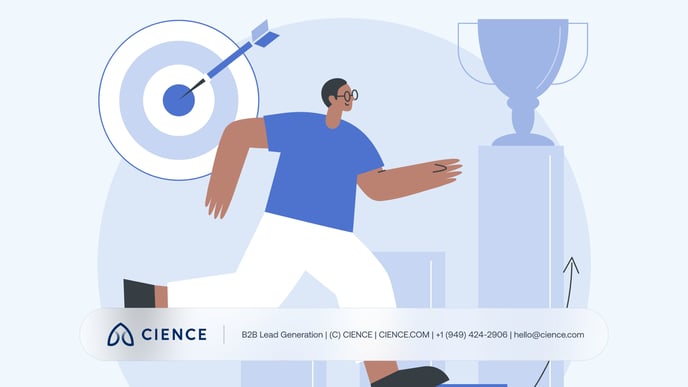 4. Assign sales activities for each stage.
4. Assign sales activities for each stage.
At each stage of the buyer's journey, the sales representative must perform relevant actions. By using pipeline management tools to track your prospects, you can follow your prospects at different phases.
Fortunately, artificial intelligence, or AI tools, can make lead generation better and faster and support you during these many phases of the cycle. In addition to generating and collecting leads from multiple channels, lead generation tools provide businesses with insights derived from collected data.
The sales pipeline stages reflect this experience's significant milestones, and each brings unique difficulties and opportunities:
- Lead generation: In this step of the sales funnel, the process of finding and nurturing inbound leads is generated by your sales efforts and activities. It takes work to generate leads for your sales team. You usually have to score fresh leads after producing them and work with sales to develop them into lucrative opportunities.
To enhance your lead generation process, it is recommended to integrate a company data API, which can offer valuable insights on prospects and leads. This can help you to tailor your sales efforts and significantly increase your chances of success. - Prospecting: This is the process of finding, locating, and developing a list of prospective clients to engage and convert them into paying customers. The more thoroughly you comprehend your consumer persona and ideal client profile, the more effectively you can target potential buyers.
- Lead qualification: This stage is the evaluation of a lead's compatibility with your target consumer profile and probability of becoming a loyal client.
- Contact: This initial contact stimulates interest in the supplied product or service. It collects sufficient information about the prospect to determine if they are a suitable fit.
- Proposal: Clients will likely request a business proposition if the presentation is successful. Send them a precise estimate that outlines the price and terms, their requirements, and how you will address the issue they are experiencing.
- Negotiation and closing: To produce a profitable transaction, you can renegotiate pricing, services, terms, etc., before resubmitting your proposal. If everything goes well, you will finally reach the stage of completing the transaction where the prospect will sign the contract and become your customer.
- Retention: You still need to handle all post-sale communication, follow up with clients, ensure their satisfaction, and cultivate a connection that will result in future purchases. According to Microsoft, acquiring a new client might be five times more expensive than keeping an existing one. For this reason, customer retention should play a significant role in your marketing activities.

5. Define the sales cycle length.
A sales cycle is the tactical and repeatable procedure salespeople use to convert a lead into a client. With a sound sales cycle in order, you are always aware of your next step and the position of each lead inside the cycle. It can also assist you in replicating your successes and identifying areas for improvement.
6. Determine the pipeline size.
The size of a sales pipeline is without a doubt an essential indicator of its health. Sales managers are searching for a magic number that can be multiplied by their salespeople's yearly quota to establish an appropriate pipeline size.
Knowing the optimal pipeline size for each sales representative on your team is crucial for generating effective and accurate pipeline management, allowing you to lead representatives toward better quota achievement.
7. Remove stagnant deals.
Deals that stagnate consume the efforts of the whole sales team. Experience will teach you how to recognize the indicators of a dead lead. Know the duration of your sales cycle and when it's time to let go of a dead lead to focus on the living ones.
8. Track sales pipeline metrics.
According to the Sales Pipeline Software Market Forecast (2021-2031) by Transparency Market Research, the growing usage of digital services in the automation sector is a crucial driver expected to drive demand for sales pipeline software throughout the projected period.
Metrics for the sales pipeline are one of the primary benefits of having a sales pipeline. Using a sales pipeline assessment can help clearly define your sales process, gain critical insights, automate tedious operations, and track metrics with the help of sales pipeline management tools. 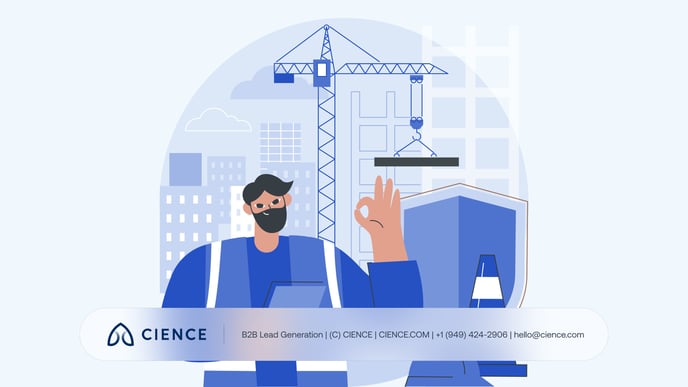
How to Grow a Sales Pipeline
Some B2B vendors may believe that closing more deals is more important than getting more leads, but having more new clients over new leads can quickly become volatile as long-term sales objectives are harder to predict.
After defining what number of incoming leads convert into clients at the end of the process, a steady sales pipeline growth must remain a top priority for business development teams.
The following actions have shown remarkable results in promoting a healthy state of development for sales pipelines:
1. Data analysis
Sales data analytics involves studying all possible information collected during a sales process. This interpretation can help data-driven decision-making for sales strategies, prospecting, and sales automation.
2. Content creation
Intent data is the collected behavioral information about digital users' web content consumption. It can be used to identify their most relevant interests and, if processed correctly, could lead to impactful insights on what content topics are the most relevant for a specific target.
3. Omnichannel integration
Omnichannel marketing boosts the brand's positioning across online and offline channels. This means that omnichannel outreach connects social media, email, apps, and phone lead generation on a single, intuitive platform to provide a holistic B2B customer experience.
4. Link building actions
Link building is a part of SEO outreach that ensures an exchange of valuable link references from one website to another. A link to your content placed on high authority sites can help search engines to determine it as trustworthy and make it rank better, display higher in the search results, and ultimately bring you more sales opportunities.
5. Prospecting planning
A sales prospecting plan applies the most optimal filters to develop solid target account lists that hold the information of accurate possible buyers. Prospecting planning analyzes every touchpoint with a prospect to discover a higher probability of success.
6. Data provider partnership
Prospects can also be obtained through intermediaries. B2B data providers are defined as digital platforms that gather, filter, and qualify enormous amounts of contact databases that usually include full names, locations, positions, phone numbers, email addresses, social networks, and other contact points.
Many B2B companies benefit from partnerships with data providers, as their contact records tend to be qualified by real sales development representatives and flavored with clear insights on how to approach each prospect.
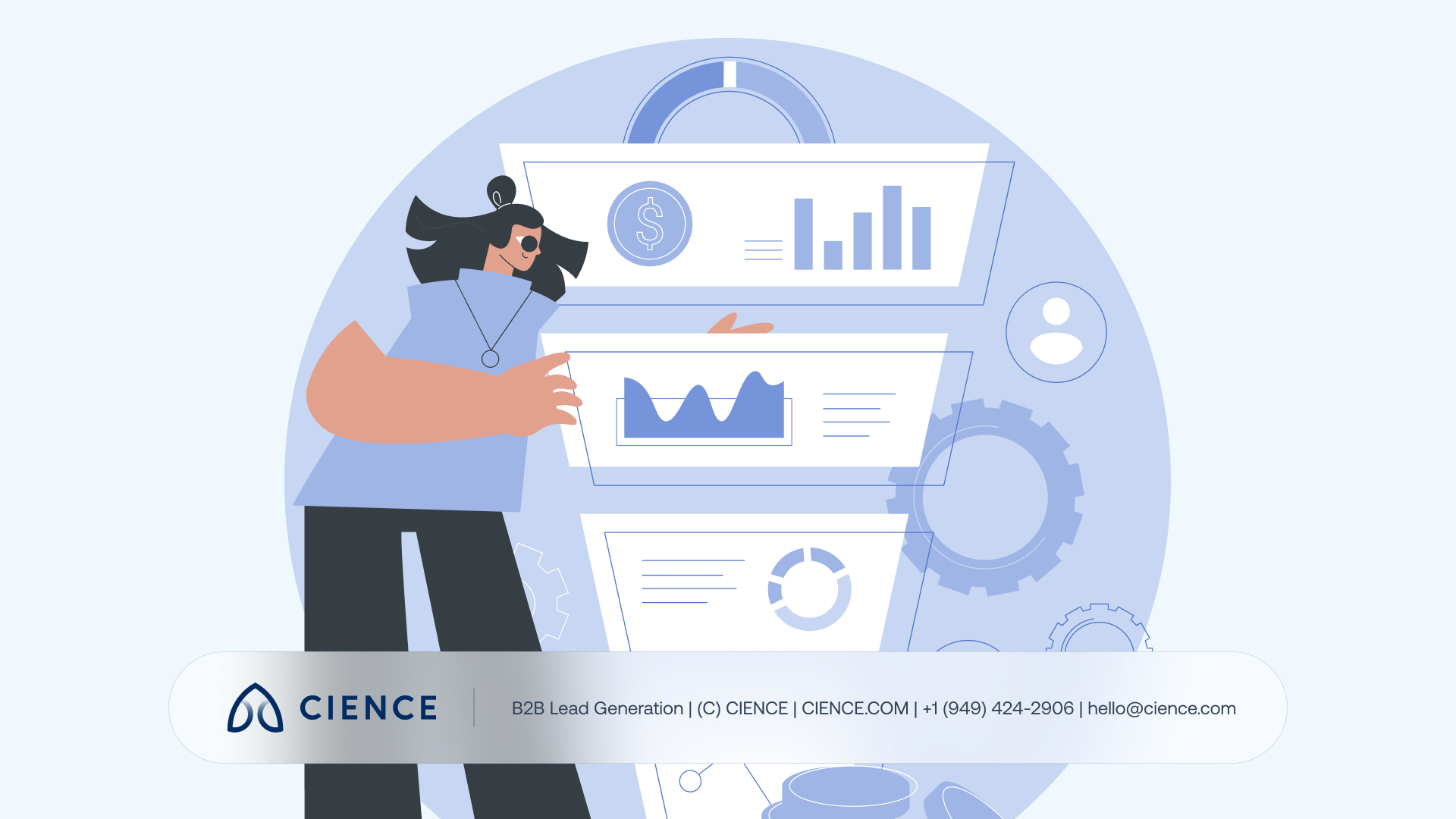
What Are Some Sales Pipeline Examples?
Innovative and practical sales pipeline templates come after many hours of processing data analytics and sales insights. Still, once they are successfully crafted, they can simplify the daily activities of entire sales departments. Here are some sales pipeline examples to gain ideas about what these look like:
Kanban-style pipeline
This Kanban-style pipeline is for tracking each lead from an opportunity card. Each card can be dragged throughout the pipeline stages: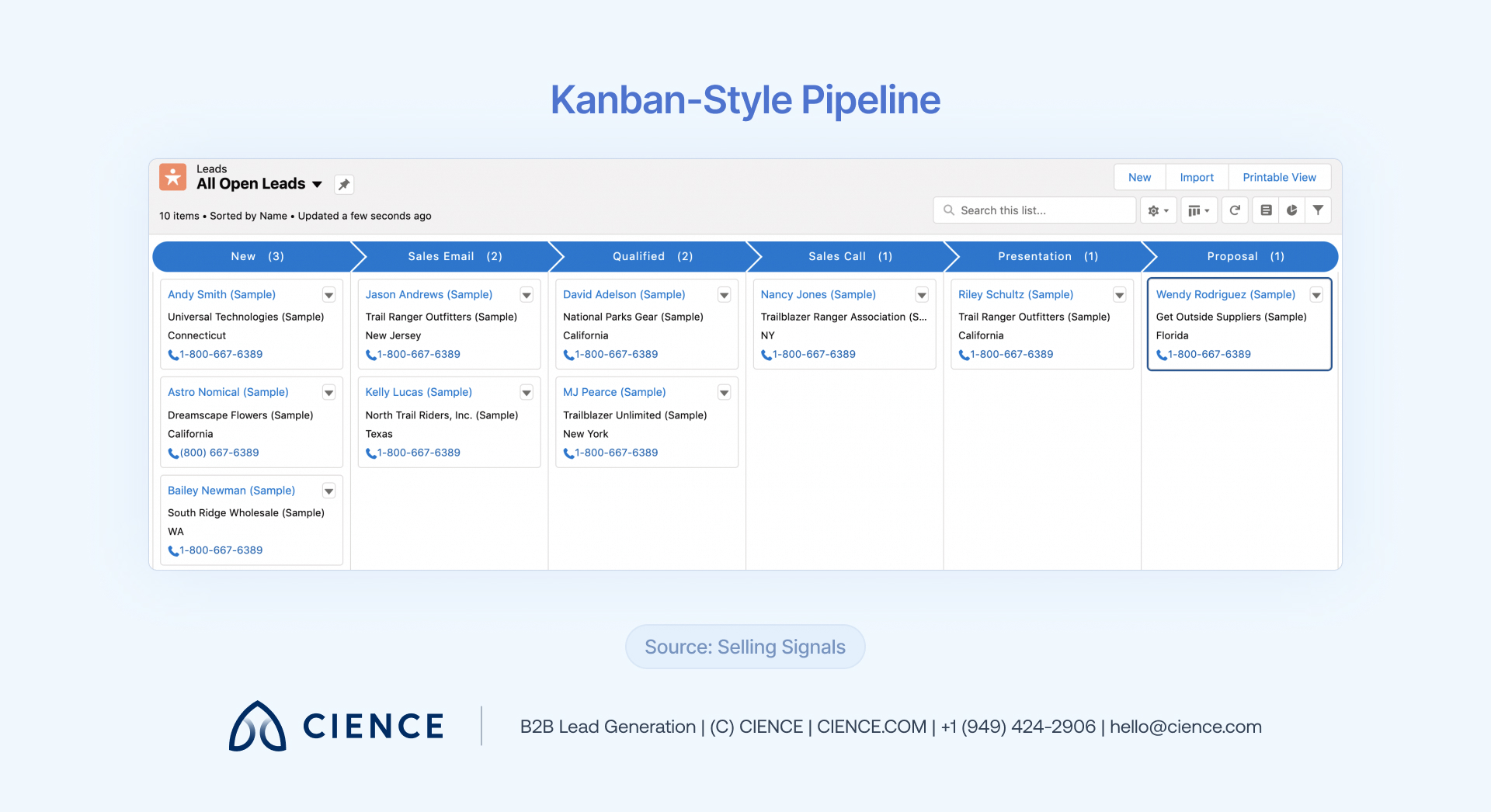
Table-view pipeline
A table-view pipeline gives you a holistic view of all leads, opportunities, and your chosen data fields: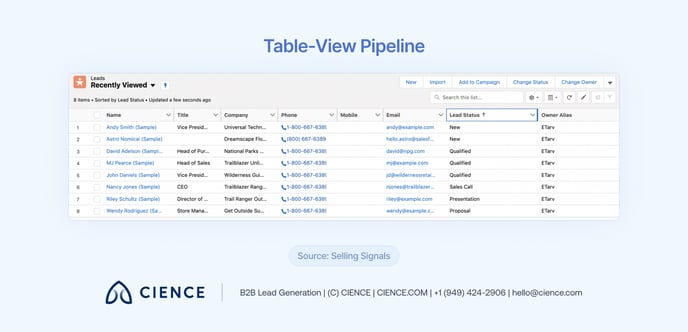
Multiple pipelines
These are necessary for businesses with more complex processes and longer sales cycles. You can also create various pipelines to monitor various units or lead types, such as a lead-sales or opportunity-sales pipeline: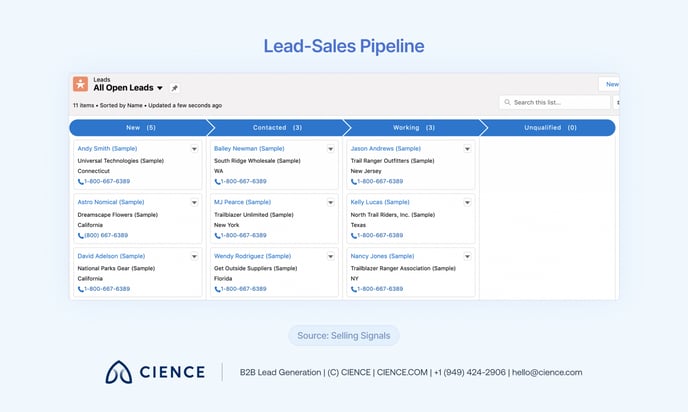
Here is an example of an opportunity-sales pipeline: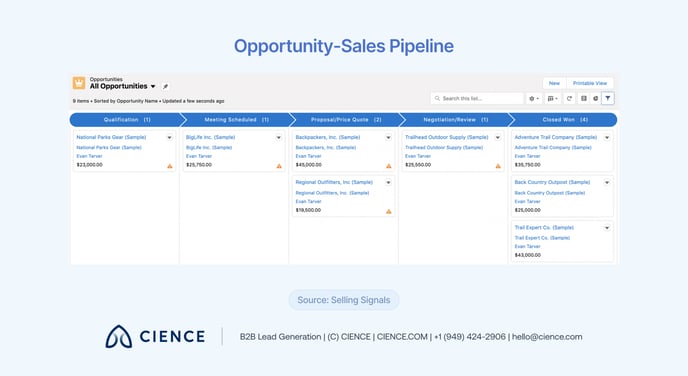
Grow Your Sales Pipeline to Boost Profitability
Effective strategies derived from sales pipelines are required for B2B companies to keep on thriving. Through ever-evolving upgrading processes, sales teams and managers will be able to correctly identify what prospects are ready to move on to the next stage, which categories of possible buyers are easier to close, and which deals are not worth pursuing.
Learning how to implement and improve a sales pipeline grants B2B marketing and sales departments the opportunity to own an eagle eye in the sky, one that can successfully dissect, analyze, and even trigger what action should be taken next to ensure the most profitable outcome.
A Few (Related) Sales Posts
 Featured image: Best of CIENCE Enterprise Sales Development Podcast: Kevin Dorsey - Read full post: Best of CIENCE Enterprise Sales Development Podcast: Kevin Dorsey
Featured image: Best of CIENCE Enterprise Sales Development Podcast: Kevin Dorsey - Read full post: Best of CIENCE Enterprise Sales Development Podcast: Kevin Dorsey
Best of CIENCE Enterprise Sales Development Podcast: Kevin Dorsey
 Read full post: Sales Trends at the Quarter-Pole: Aligning Process and Strategy
Read full post: Sales Trends at the Quarter-Pole: Aligning Process and Strategy
Sales Trends at the Quarter-Pole: Aligning Process and Strategy
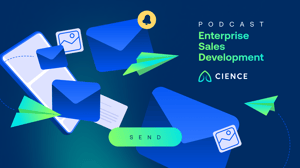 Read full post: Exploring Email Marketing Insights with CIENCE ESD Podcast
Read full post: Exploring Email Marketing Insights with CIENCE ESD Podcast



